This website is supported by its readers. If you click one of my links I may earn a commission. I am also a participant in the Amazon affiliates program and I will also earn a commission from qualified purchases.

With over 35 sub-species, Elm trees and, more specifically, Chinese Elm trees are among the most popular trees kept for both indoor and outdoor use. These trees are incredibly robust and are commonly used for bonsai, creating shrubs and hedges. Recently I noticed one of my Chinese Elms trees was leaking. This got me asking the question, do Chinese Elm trees drip sap?
Chinese Elm commonly drips sap from cuts, grooves, and wounds on the tree. This sap is caused by bacterial infections that push the sap out of these cuts in your tree. This condition is known as Wet Wood Disease or Slime-Flux.
So is there a cure to prevent your Chinese Elms trees from dripping sap? And what are the route causes of Chinese Elms trees dripping sap? Keep reading to find out more.
Just a quick heads up, over the past three years of running Plantpaladin, hundreds of people have asked for product recommendations. As such, You can find my favorite indoor bonsai tree here (link takes you to Bonsaiboy), my favorite outdoor bonsai tree (link takes you to Bonsaiboy), or have a look at all the products I recommend here.
Do Chinese Elm trees drip sap?
To get to the bottom of why and how Chinese Elm trees drip sap, I got in touch with a few tree experts, visited my local botanical gardens, and even did a quick survey of 10 Plant Paladin readers who own Chinese Elms to ask them if their Chinese Elms trees drip sap.
All this to ensure that you had the most comprehensive post on why Chinese Elm trees drip sap.
To summarize:
- It is common for Chinese Elm trees, other Elms varieties, and other fast-growing shade trees such as Willows and Cottonwoods to drip sap.
- The most common reason for sap dripping from Chinese Elms is a bacterial infection in the heartwood (the central supporting pillar of the tree).
- The bacterial infection blocks vital nutrients, water, and other essential elements in the trunk of your Chinese Elm.
- This bacteria eventually produces a gas that pushes the sap out your tree.
- The sap will most commonly appear on Chinese Elms trees from small cracks, cuts, or fresh wounds.
- An example of this would be if you have recently trimmed back or removed a branch from your tree, the sap may start to flow from the wound.
- While the sap can leave a foul smell, it is usually more of an annoyance than harmful to your tree.
- However, it can cause added stress in your tree, which can kill an unhealthy tree if left unchecked.
- Another cause of sap dripping from your Chinese Elms would be working in the tree too early in the spring when it has a lot of fluid still left in the branches.
- If this is the case, prune, cut, and wire your Chinese Elms in the middle of summer.

Let’s explore this in more detail:
Why do Chinese Elm drip sap?
The most common reason Chinese Elm trees drip sap is a bacterial infection. The gasses caused by the bacteria in the heartwood push the existing sap out of the tree through fresh wounds or cuts.
The most common bacterial infection that causes Chinese Elm trees to drip sap is Slime Flux, also known as Wet Wood Disease.
The most frequent way trees develop Slime flux is through wounds in a tree.
Wounds are commonplace in Chinese Elms and can be created manually by cutting and pruning branches, wiring, trimming back leaves, or even repotting your Chinese Elms tree.
Wounds can also occur naturally, such as when insects bit or chew the bark of your tree, through general wind erosion, and other natural phenomena.
For Chinese Elm bonsai, creating wounds and cuts will be a process you undertake several times per year.
Wounds and cuts will also appear naturally in your tree from age, ice freezing, insects, cats, and birds all picking at and scratching your Chinese Elm.
How do these cuts lead to Chinese Elms dripping sap?
Once your Chinese Elms have sufficient cuts and gouges, bacteria will start to enter your tree, whether artificial or not.
This bacteria will slowly enter the xylem of your Chinese Elms and, over time, ferment, increasing the internal pressure in the tree through a volatile mix of gasses such as methane, nitrogen, carbon dioxide, and oxygen.
The PSI of a typical Chinese Elms will be between 5 to 10 PSI. Once the bacteria enter your tree and start producing gas, this will increase to upwards of 60 PSI.
This pressure will make part of your tree start to have a damp, brown appearance (where the name Westwood comes from).
If left unchecked, the pressure will continue to build and eventually force the sap out from the inside of the Chinese Elms.
The diagrams below will help explain the exact process in more detail:
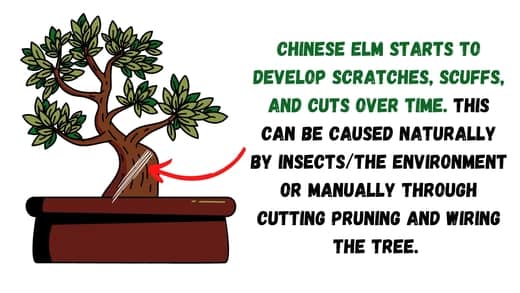
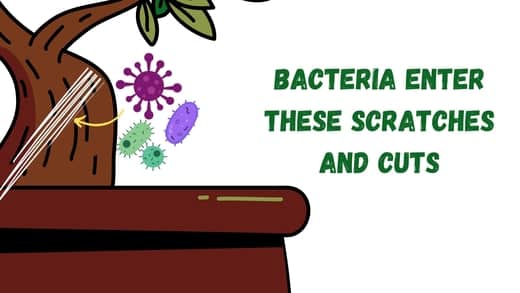
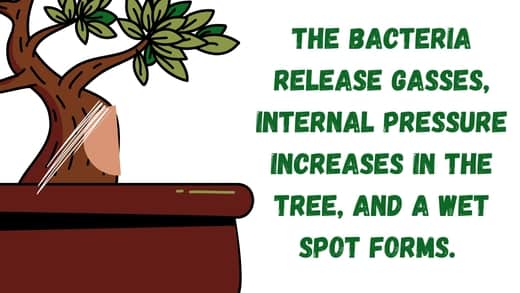
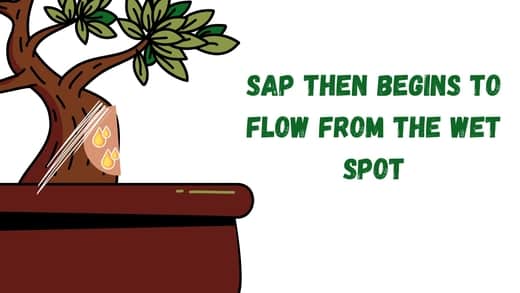
Problems with Chinese Elm dripping sap
It’s natural for some sap to drip from your Chinese Elm over time.
However, excessive amounts of sap will start to leak from your tree if left unchecked.
Excess sap leakage can cause a foul smell and attract yeasts, fungi, and other microorganisms.
What’s worse is if you keep a dog, the smell is attractive to dogs, and it is common to find dogs rolling around near this smell.
Once other bacteria and mold interact with the smell, it can turn the sap caustic, which can drip onto the grass and other organic material surrounding trees in your collection and corrode them.
Excessive sap dripping from your Chinese Elm can also stress your tree and cause branches to wither and die through branch dieback.
Using your Chinese Elm tree for bonsai will take longer to recover from stressful activities such as wiring or repotting.
This weakened state will also make your Chinese Elm more susceptible to insect infestations such as Aphids, Spider-mites, Scale, and Caterpillars.
Will Slime Flux kill my Chinese Elm?
While not fatal in the short term, slime flux, if left unchecked, can attract insects, mold infections, yeasts, and other pests to attack your tree further. These pests, mold, and diseases will cause your tree to weaken further and eventually kill your tree if left unchecked.
How to prevent your Chinese Elms from dripping sap?
There is no way to prevent or cure sap dripping from your Chinese Elm caused by Slime flux/wet wood disease.
Instead, it is all about managing the symptoms of the disease so that your Chinese Elm can continue to grow despite the bacterial infection.
The following steps then can be taken to help keep your Chinese Elm as healthy as possible if it is facing dripping sap:
Wipe with bleach
As soon as you see signs of excess sap leakage from your tree, it would be good to wipe this away and clean your tree.
You can do this either with rubbing alcohol or with bleach (a solution of 10% bleach to 90% water works well)
Apply this solution to fresh wounds and the cuts of your tree to prevent further sap from leaking from these spots.
Remove excess sap
Once you have cleaned your tree and cleaned the wounds from your tree, it would be good to wipe away any excess sap.
I like to use a dry cloth to apply pressure to the wounds gently and wipe them away.
I find that blotching the wounds as opposed to wiping yields better results.
Doing this will prevent pests such as Aphids that like to feed on sap from attacking your tree.
Once you have removed the sap, you can repeat step one to prevent further bacterial infection.
Remove the bark
A more robust method you can follow if your tree is only suffering from sap leakage in one spot is to remove the bark from your tree.
Removing the bark will remove any excess bacteria that may have built up in the cambium and prevent your tree from spreading to the rest of your tree.
However, keep in mind that Bark is not like skin and may not grow back.
Use mulch and compost around the drip line.
A tree dripline is the outermost circumference of a tree canopy, i.e., the widest points of your tree and its perimeter.
When your tree has been weekend through dripping sap, it is essential that we pay extra care and provide excess nutrients and care in and around the tree’s dripline.
The best way to do this is to add mulch/compost to the top of your potting soil.
Mulch and compost will contain vital nutrients such as nitrogen, phosphorous, and potassium essential to your tree.
Placing these items in and around the dripline will mean faster absorption keeping your tree as healthy as possible.
General care
If your Chinese Elms are suffering from excessive sap leakage, pay close attention to the general needs of the tree.
Chinese Elm loves bright sunny conditions and should be watered twice per week.
Chinese Elms are also relatively fast-growing and need to be reported once every two to three years and given fertilizer once per month in the summer months.
If general care is not maintained, this problem will be exacerbated.
Avoid pruning your tree.
Part of the reason your tree is likely dripping sap excessively is due to cuts made when you trimmed or pruned your tree.
I would recommend not to make unnecessary cuts that can further speed up the process of decline in your tree caused by bacterial sap leakage.
Do not release the pressure yourself.
A few years back, it was advisable to treat excess sap leakage from Chinese Elms by sticking a tube or pipe between the bark and inner wood of the tree.
The theory behind this was to release some of the pressure built up in the tree to push the sap out.
While this did have some positive results, the truth is that this ended up causing more significant damage to Chinese Elms.
As such, it’s something you should avoid
How to stop Chinese Elm sap from smelling?
A side effect of Chinese Elms dripping sap is a foul smell.
Bacteria often mix with the sap when your tree starts to leak and can attract other yeasts and molds, further adding to your tree’s foul smell.
Dogs are attracted to the smell and love to roll around in the sap a Chinese Elm produces when diseased by slime flux.
To counter the foul smell, use a damp cloth or swab consisting of 10 parts water and 1 part chlorine bleach and thoroughly rub on the cracks/spots producing the bad smell. Repeat this process when the smell arises again.
What bacteria causes Chinese Elm to leak sap?
Enterobacter Cloacae is the primary bacteria that cause excess sap leakage in Chinese Elm trees. Other bacteria that can cause sap leakage include Xanthomonas, Agrobacterium, Acinetobacter, Corynebacterium, and Bacteroides.
Other causes
While bacterial infections are the most common reason for excess sap leaking from your Chinese Elm, another primary reason is simply working on your tree too early in the year.
Trees go through different stages of energy flow throughout the year, typically having less energy in the winter and more in the summer.
Typically hen in the early spring, your Chinese Elm will have more energy as it starts to come out of its dormancy period.
If you start to work on your Chinese Elms early in the spring, as recommended for Chinese Elms bonsai trees, you might find that this excess sap leaks from your tree.
If you feel this is the case, consider pushing back your pruning to mid-spring/summer.
Survey results – Do Chinese Elm trees drip sap?
Finally, I asked ten plant paladin readers who keep Chinese Elm bonsai trees if their Chinese Elms leak sap – here are the results:
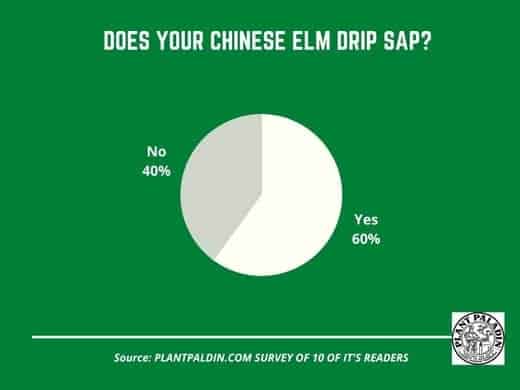
My top picks for the gear you will need!
So like I mentioned earlier, over the past three years of running PlantPaladin, hundreds of people have asked me for my recommendations on the best bonsai gear on the market.
Having spent thousands of dollars on bonsai items these past few years and tested at least 100 bonsai-specific products, I’ve listed my favorite products below – All of which I highly recommend and think you can get great value.
They can purchase directly by clicking the link to take them to Amazon.
Bonsai Tool Set: One of the significant challenges I’ve had is finding a toolset that was not only durable but didn’t break the bank. SOLIGT has recently developed a fantastic bonsai tool set that covers all the tools you need to trim, prune, and repot your trees. – You can grab it here.
Complete Bonsai Set: Many of you will want to grow your bonsai trees entirely from scratch, but finding the varicose seeds, pots, and other items in one place can be challenging. Leaves and Sole then have created a complete bonsai set that I’ve personally used that ticks all the boxes. You can grab it here.
Bonsai wire: The number of times I’ve run out of wire for my bonsai or purchased cheap bonsai wire that doesn’t do the job is embarrassing for me to admit. After a lot of trial and error, I found that using Hotop’s aluminum bonsai wire is one of the best options on the market. This can easily be used for both indoor and outdoor bonsai. You can grab it here.
